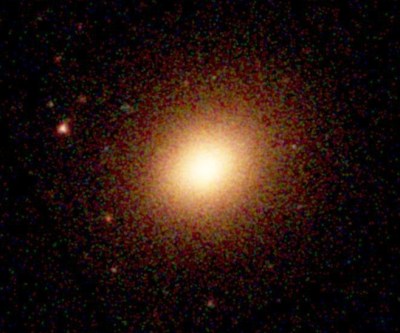Science
Clusters of galaxies are the largest structures in the universe. They usually contain more than 100 galaxies in a limited space of about 10 million light years in diameter. The big gravitational field of the cluster pulls in galaxies, but also hot gas which is there since the Big Bang. This hot gas gets compressed, shocked, and therefore even hotter when it enters the cluster. In the cluster core it reaches a temperature of 10 million degrees! Gas of these temperatures is not visible in optical light, but in X-rays. To study this gas we use ESA's X-ray observatory XMM-Newton.

X-ray image of the cluster of galaxies Sersic 159-03 (XMM-Newton).
The Cooling-Flow problem
The X-rays in the cluster gas are emitted because of collisions between free electrons and atoms. With each collision, energy is taken from the electrons and atoms to make an X-ray photon. Because almost all X-rays escape the cluster without hitting other atoms, this energy is lost. The particles in the cluster gas therefore get a lower speed and consequently, the gas gets colder. If the density (the number of particles per unit of volume) is high, this process occurs more frequently and more X-rays will be emitted. Cool dense gas is therefore brighter than hot dilute gas.
In the case of a cluster this mechanism is causing a run-away effect. Think about what happens: Through collisions the gas loses X-ray photons and cools. Because of the cooling the pressure of the gas drops, the gas shrinks and the density increases. This increased density leads to more collisions and X-ray emission and thus to more cooling. The temperature in the dense core of a cluster should drop rapidly! However, when we look at clusters with XMM-Newton we do not see the cool gas. The gas appears to be hotter than this theory predicts!
So far, we do not know which mechanism heats the hot gas in the cores clusters of galaxies. There might be a giant black hole in the center which heats the gas by blowing hot material into space. Also mixing hot gas from the outer parts of the cluster with the gas in the core is an option. We just do not know for sure...
Merging clusters
Clusters of galaxies are still growing. Galaxies from the space outside the cluster continuously fall into the cluster. Sometimes even two complete clusters fall toward each other and merge. During this merger the hot gas in the two clusters collides, which produces a huge shock wave. In X-rays we are able to see these shocks in a large number of clusters! This means that the universe is still a very active place!
Polluting the hot gas with metals
If individual galaxies fall into a cluster, the gas between the stars of the galaxy just gets stripped away because of the friction with the hot gas. Galaxies like our Milky Way contain a lot of dust and molecular clouds. All this gas with metals, which were made by supernovae (exploding stars), are mixed with the hot gas. This way, the hot gas is polluted with all kinds of stuff.
Using a technique called X-ray spectroscopy we can see the fingerprints of the metals in a cluster and determine their amounts. This is possible, because atoms in a hot gas tend to emit more X-ray emission at certain wavelengths (colours). When a spectrometer observes the light, it can separate it in different wavelengths like a prism. If there are, for example, iron atoms in the gas, then the spectrometer will show several bright lines at certain wavelengths. From the wavelengths we can then determine we are looking at iron.


XMM-Newton (left) and Chandra (right).
Since 1999/2000 there are two big X-ray telescopes in orbit which can perform X-ray spectroscopy on clusters of galaxies: XMM-Newton (ESA) and Chandra (NASA). Both satellites are specialized in detecting X-rays, but there are some small differences. XMM-Newton has a large collecting area and it can do imaging and high-resolution spectroscopy at the same time. Chandra is better in producing sharp images, but needs a longer exposure time. High-resolution spectra can not be obtained in the same time with images.
XMM-Newton and Chandra partly solved the cooling-flow problem, which I describe above. This is one of the major discoveries during the last years in the field of clusters of galaxies. However, in order to learn more about the structure and chemical evolution of clusters, new instruments are necessary. Therefore, new satellites are being planned and built. In the summer of 2005 the Japanese Suzaku satellite was launched. Suzaku has a spectrometer onboard with a higher spectral resolution than current imaging instruments. Unfortunately, this instrument broke down during the test phase. But the quest for high-resolution spectroscopy in X-rays continues! Around 2021 we hope a new Japanese mission called Astro-H2 will be launched, which will fly a new spectrometer. After 2028, we expect the launch of the ATHENA X-ray Observatory that has even more sophisticated instruments on board.
Other activities
- SRON Ondernemingsraad (2012-2021)
- NWO Centrale Ondernemingsraad (2014-2016)
- Blogger Wetenschap.nu
